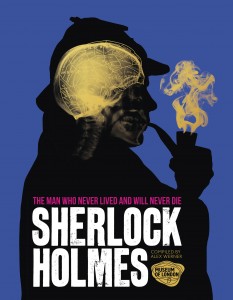Book Review: Sherlock Holmes – The Man Who Never Lived and Will Never Die
Sherlock Holmes – The Man Who Never Lived and Will Never Die – The Museum of London Companion to the Exhibition
When I received a review copy of the catalogue of/companion book to the Sherlock Holmes exhibition at the Museum of London, my first impression was that it is impossibly pretty. I know, that’s not a particularly objective comment, but it’s true. It’s a beautiful book; and an absolute must have for any fan/aficionado/lover of Sherlock Holmes, Arthur Conan Doyle and Victorian and Edwardian London!
The cover itself is amazing and once you open it, you find a map of London from 1880 inside. The modern look of the cover stands in stark contrast to the map inside and once you start to turn the pages, you find yourself in nineteenth century London. Almost every single one of the 255 pages feature an image and information on different aspects of Sherlock Holmes and his world.
Each chapter focused on a different aspect of Sherlock Holmes and his world – from the creation of and inspirations for the character, the London of Sherlock Holmes, Sherlock Holmes, the illustrations by Sidney Paget and the Strand Magazine all the way to Sherlock Holmes in cinema and television. Each chapter is illustrated with the original illustrations of the Sherlock Holmes stories by Paget, contemporary photographs, newspaper clippings and art.
The book offers an insight into the history of the late nineteenth century, the rapid development of London and Arthur Conan Doyle’s connection to the great metropolis. Accompanied by photographs, paintings and drawings, the introductory chapter by David Cannadine highlights Arthur Conan Doyle’s connection to London as well as the historical, social, political and geographical issues Doyle’s work and specifically the Sherlock Holmes stories touch on.
The next chapter by John Stokes discusses the ‘bohemian habits’ of Sherlock Holmes, delving into Fin de Siècle culture, aestheticism, concert and theatre visits, dress code and the art of disguise. A whole way of life is summarized, offering a greater context to the city life and the social environment of Sherlock Holmes and John Watson in the stories.
This insightful chapter is followed by a compilation of postcards, photographs and art prints of London at the turn of the century. It’s a marvellous collection, accompanied by fitting quotes from the Holmes stories. The images add depth to the stories which I had not known I missed until I held this book in my hand. Suddenly, the world of Sherlock Holmes, although only partly corresponding with the real London of the turn of the late nineteenth and early twentieth century, becomes a real place.
Alex Werner’s chapter on Sidney Paget and the Strand Magazine reflects on the relationship between Arthur Conan Doyle, his English Sherlock Holmes illustrator, the magazine and the reading public, accompanied by gorgeous prints of some of the original (coloured) illustrations by Sidney Paget.
Pat Hardy writes about the industrial and cultural development of London, famous London views and the London fog, again featuring paintings and photographs, among them the utterly gorgeous painting “Westminster Bridge, the Houses of Parliament and Westminster Abbey seen from the River” (1872) by John Anderson and photographs by Alvin Langdon Coburn. These eerie photographs of famous London sights in particular send the reader on a journey back in time and connect us with the London of the early twentieth century. You can just imagine John Watson and Sherlock Holmes strolling through Leicester Square in the rain or stopping by Cleopatra’s Needle.
Clare Pettitt highlights the influence of the Sherlock Holmes stories on print media and the fate of the stories as throwaway literature in a time when mass production of literature was on the rise. Pettitt furthermore explains the importance of Holmes’s use of modern communication technology at the turn of the century as well as the use of newspapers to deliver encoded messages – a matter which features in several of the Sherlock Holmes stories.
Following a small collection of maps of Sherlock Holmes’s London from the turn of the century, the next chapter follows Sherlock Holmes though the early stages of appearances on the silver screen. Nathalie Morris writes about the first Sherlock Holmes films – a chapter which includes behind the scenes images of several early productions, production posters and detailed information on the first filmic adventures of Sherlock Holmes up to 1939.
The final chapter features gorgeous prints and basic information on Sherlock Holmes adaptations after the 1940s. For all the wealth of information this catalogue offers the reader, the price of £25 is already justified by the fantastic prints of Basil Rathbone, Jeremy Brett and David Burke, a super lovely (yes, sorry, I am a bit biased) print of Benedict Cumberbatch and Martin Freeman in character in front of 221B Baker Street and the film posters of Guy Ritchie’s first Sherlock Holmes film and Elementary.
The book is out today, 16 October 2014, and is available at the Museum of London, in a whole lot of book stores, and, of course, online. It’s also currently on sale on amazon.co.uk!
The exhibitions opens on Friday, 17 October 2014 and runs until 12 April 2015!
I wholeheartedly recommend this book, as it is a delightful treasure box which will bring a smile to your face whenever you open it (or pet the pretty cover). It’s easily become one of my favourite companion pieces to Sherlock Holmes and his world!
Best 25 pounds you’ll ever spend!

Maria teaches English Literature at Leipzig University, Germany, published a German introduction to Sherlock Holmes and is a fan of all things Holmes – but especially of the Canon stories and Sherlock BBC. Contact her at @stuffasdreams
